The Lure-Making Tips blog is for readers who already know the techniques and methods explained in the books Lure-Making 101/102 and Lure-Making 201/202. If you don’t have these books, be sure to get them.
More lessons from the long-view of history. Perhaps a good reminiscence for old-timers who were among the first generation of “Kona-Style” lure makers and users in the 1950s and 1960s. For newcomers who didn’t get started until later, perhaps this and other stories in the Lure-making Tips blog will nudge you to respect your elders. But there is nothing really heavy in this post. Just a few things worth pondering. I’m starting with a picture of some 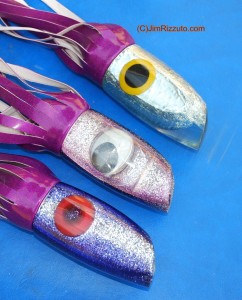 of my now-familiar work. I am using my work only because I know the details of when and how it was created, and I don’t need to speculate on important facts.
of my now-familiar work. I am using my work only because I know the details of when and how it was created, and I don’t need to speculate on important facts.
The three lures shown at left came out of the same mold over a period of about 45 years. The top one is the reason for showing the image. Note the color. Today’s lure makers know that pale blue color by the code name “Evil” and associate it with the Joe Yee Apollo (below right).
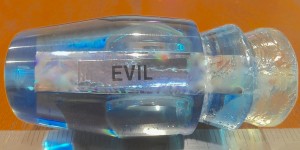
I made this Fat Boy lure (left, top) in 1970 or, perhaps, even earlier. The color was very popular back then, just as it is now. Before it became known as “Evil,” it was just plain evil to the fish.
On that same Evil blue lure, note the yellow and black eye. It was made by pouring two layers of resin, first black and then yellow, into a mold made with small curved pockets. Today, we use plastic painter’s palettes. Back then, we used a rubber mold that we created by embedding coat buttons in the uncured rubber. It seems that every generation “discovers” the process of pouring their own eyes and decides they invented it.
Now note the insert. This lure predates all of the fancy, flashy, mylar film tapes we now have today. On this lure, the shiny surface is aluminum tape press-fitted over a plastic “popsicle” insert. To add some texture, I stippled the tape with a rough-tooth file.
Let’s look at a few other lures from the same era. 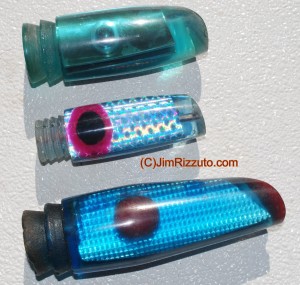 I don’t know who made them but we can make the point just from their features.
I don’t know who made them but we can make the point just from their features.
There’s that pale blue color again. The slight difference in the hue is probably because of variations in the color of the resin, itself.
The top lure has a shiny metal insert, which was polished like a mirror. The bottom has a textured metal insert. The middle lure uses some early fish-scale patterned mylar tape.
Note the tail pieces on the top and bottom. The two-notch dovetails were already the standard back then. They were molded into the lure rather than being carved on a lathe. Lathing was difficult to do because the leader tubes were off-center. The grooves were left unpolished — even left tacky. Better to hold the skirt.
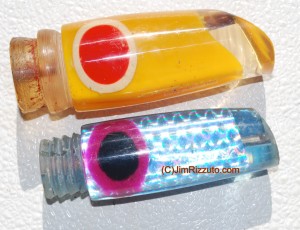 Look at the tail stock for a big clue to the age of the top lure. Old-timers will recognize the clue immediately. They will understand the meaning of that strange orange residue on the rear piece. Back in the day, our top choice for underskirt material was red rubber from inner tubes, but we could also buy orange sheet material to cut into a hula skirt. The inner tube rubber lasted longer. The orange sheet rubber eventually got gooey and sticky.
Look at the tail stock for a big clue to the age of the top lure. Old-timers will recognize the clue immediately. They will understand the meaning of that strange orange residue on the rear piece. Back in the day, our top choice for underskirt material was red rubber from inner tubes, but we could also buy orange sheet material to cut into a hula skirt. The inner tube rubber lasted longer. The orange sheet rubber eventually got gooey and sticky.
Look at the eyes, too. Molded from leftover resin, most likely. As already noted, the practice goes back almost to the beginning.
One last look. In a previous post, I mentioned the practice of leaving the nose of the lure unpolished. Polishing was a pain so many folks convinced themselves that rough noses were better anyway. 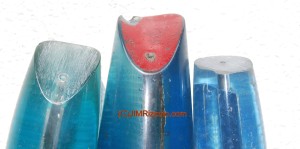 If the nose is left unpolished, you can tinker with it more easily to tune it up to run true. The center lure shows a red-painted nose — a common practice that made the front look more finished.
If the nose is left unpolished, you can tinker with it more easily to tune it up to run true. The center lure shows a red-painted nose — a common practice that made the front look more finished.
Do you see that the red nose is not really squared up? This lure would tend to pull to one side. The lure maker might have wanted that to happen to spread the lure out to one side of the wake. In any event, look at the big chip in the scoop. That eventually happened to all good lures in heavy use. In the final chapter of a lure’s life, the chipped ends were filed off to create new models with different actions. And thus some entirely new shapes were accidentally “discovered.”
For reasons that make no sense, these scoop-faced lures are occasionally referred to as “conventional” lures. With any development, the “convention” is established by the original product. In the case of Kona-style trolling lures, the convention is the Henry Chee straight runner with the center pull and the flat beveled face. If we were adhering to common practice, the “convention” would be the center-pull, tube lure made in a bar glass.
Jim Rizzuto
to Keith Prinn from Jim Rizzuto: Fascinating and well documented. So “Evil” began as the name of a skirt in the Pakula line and then got borrowed as the name of a lure head color in the Joe Yee line and is now used as a generic term for pale blue heads. Just another example of what gets lost and gained in translation from Australian to English. And the story does support the points made in my post: the color has been around for as long as lure-makers have been making trolling heads; it is not and has never been the particular property of Joe Yee, even though that is the usual association here in Hawaii.
Jim Rizzuto
More from Keith Prinn: Further support for the skirt colours being named Evil rather than the head colour comes from Peter Pakula having the same skirt colours in his range on his Evil Animal since the late 80s-early 90s or so when he released the Sprocket and Animal series of heads. The HTS catalogues I have from 1990 and 1991 have Joe Yee Evil Apollos featured but one year has a clear head and the other has the famous blue (as I know it to be) light blue head. Also the Evil skirts originally have the silver outside at the top with blue under this is often reversed by later luremakers using the nickname. HTS skirted the Apollos with Golden Bait skirts from memory which I believe to be Yamashita skirts.I guess I am saying there was one original nicknamed Evil lure skirt combo just like there was one Lumo being Pakula’s. Lots of others have used the names since then of course and today in Australia they are as commonly used as names like Hoover or Xerox in their respective fields. Other skirt and head combos in that era for Joe Yee Apollos at HTS were nicknamed Evil’s Brother, Evil’s Sister and Evil Brown Dog etc. I was told by someone that Peter Pakula and Chris Hall fished together with Joe Ritchie at times but I havent confirmed that personally with either Chris or Pete. I think the first HTS catalogues may have been 1988 or 89 but not 100% sure on that the actual catalogues I have are 1990 and 1991. The similarities between the HTS catalogues and the first Melton’s catalogues are also no coincidence. I am fortunate to still own a number of Joe Yees and a Marlin Magic bought from HTS in that era including two Apollos, three 501s, three Bubbles with a sole MM “Zip Rocket” Big Eye remaining from the MMs I bought. I am convinced that the connection between Melton’s and staff from HTS is what lead to the use of the nickname “Evil” in other non Australian areas after the combo was advertised as such on Joe Yee Apollos listed in Tracy’s catalogues. Other nick names such as “Big Dog”, “Slash” and more recently “Grimace” used by HTS are also often used today by some lure makers and in the current Melton’s catalogues. US nicknames for skirt combos are also regularly used here in Australia today with eg: “Petrolier, “Gay Bob” and “”Zuccini” appearing here.
Jim Rizzuto
From Keith
Prinn: The adoption of the name “Evil” as far as I am aware came about with the late Joe Ritchie running the now famous Apollo with the silver blue outer skirts over green and gold on his boat “Jah Ah” off Sydney and Port Stephens. As I was told it was given that nickname after a particularly successful day on blue marlin. So the Evil name refers to the lure in that format not just the lure head colour. The lure took off in the US after Melton’s advertised them that way but Chris Hall who fished with Joe Ritchie on “Jay Ah” rigged and sold heaps back in those days when he and Ian MIller worked for Harbord Tackle Supply. HTS back then is still the best tackle shop Ive ever visited. Evil became known as part of the famous blue marlin pattern run by Sydney boats including “Cintra” and “Jay Ah” which included a Large Marlin Magic Tube nicknamed “Slash” the “Evil” Joe Yee Apollo, a Marlin Magic big plunger named Big Dog and a Joe Yee 501 named after Sydney GFC fisho and great mate Graham Donaldson and nicknamed “Grimace”.